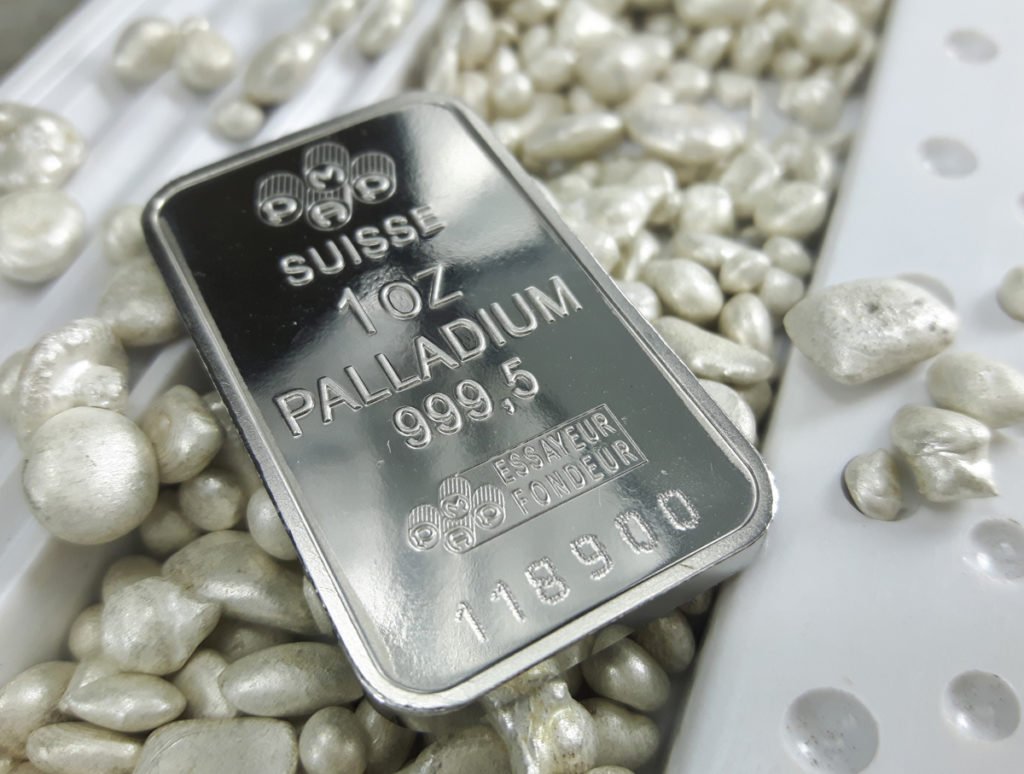Palladium belongs to the platinum group metals (PGMs) and stands as one of the rarest metals on Earth. Over the past few decades, palladium’s unique physical and chemical properties have led to its usage in a wide array of applications ranging from automotive to electronics and beyond. This blog post delves into the multiple sectors and industries where palladium is used, underlining its integral role in our lives and the modern technological world.
Discovered in 1803 by William Hyde Wollaston, Palladium is named after the asteroid Pallas, in turn, named after the Greek goddess of wisdom, Pallas.
Palladium is a shiny, silvery metal used in many types of manufacturing processes, particularly for electronics and industrial products. It can also be used in dentistry, medicine, chemical applications, jewelry, and groundwater treatment.
Some of the properties that make palladium valuable include its exceptional ability to absorb hydrogen, excellent catalytic characteristics, corrosion resistance, and stability at high temperatures. These unique traits have led to its usage across multiple industries, making it a vital component in many everyday items and cutting-edge technologies.
The majority of the world’s supply of this rare metal, which has the atomic number 46 on the periodic table of elements, comes from mines located in the United States, Russia, South Africa, and Canada.
Specifics about Palladium
- Along with platinum, rhodium, ruthenium, iridium, and osmium, the metal is part of a group known as platinum group metals.
- Palladium is a precious shiny gray-white metal that resists corrosion, is extremely ductile, and is easily worked.
- It is more durable and harder than gold and is also more expensive per ounce.
- Pure palladium is malleable, but it becomes stronger and harder once someone works with the metal at room temperature.
- The bulk of the world’s palladium supply comes from Russia, South Africa, the U.S., and Canada.
- It is 30 times rarer than gold and not tarnished by the atmosphere at ordinary temperatures.
- Relatively small amounts of palladium alloyed with gold yield the best white gold.
- Palladium has no known biological role. It is non-toxic.
- Natural abundance: It has been found uncombined, in Brazil, but most are found in sulfide minerals such as braggite. It is extracted commercially as a by-product of nickel refining or a by-product of copper and zinc refining.
Where Palladium is used?
- Due to its ductility, it is used in many electronic and industrial products.
- Palladium can be rolled into sheets, which are then used in applications like fuel cells and solar energy.
- The metal and its alloys serve as substitutes for platinum in jewelry and electrical contacts; the beaten leaf is used for decorative purposes.
- It is used in the electronics industry in ceramic capacitors, found in laptop computers and mobile phones. These consist of layers of palladium sandwiched between layers of ceramic.
- It is used also in dental alloys, some dental fillings, and crowns.
- Palladium coatings, electro deposited or chemically plated, have been used in printed-circuit components, and multilayer ceramic capacitors.
- Most of it is used in catalytic converters automobiles, fuel cells to generate power, jewelry, dental fillings, and electronic components.
- Metalworkers can create thin sheets of palladium down to one-two hundred fifty thousandths of an inch. The sheets are then used in applications like solar energy and fuel cells.
- White gold is an alloy of gold that has been decolorized by alloying with another metal, hence used palladium for jewelry.
Palladium Metal Benefits
Jewelers first incorporated palladium into jewelry in 1939. When mixed with yellow gold, the alloy forms a metal stronger than white gold. In 1967, the government of Tonga issued circulating palladium coins touting the coronation of King Taufa Ahau Tupou IV. This is the first recorded instance of it being used in the coinage.
Automotive Industry: Palladium in Catalytic Converters
The automotive industry is the biggest consumer of palladium, specifically in the manufacturing of catalytic converters. These devices are designed to reduce harmful emissions from vehicles by converting pollutants into less harmful substances. Palladium, along with platinum and rhodium, serves as a catalyst in this process.
In particular, palladium helps in converting harmful gases like hydrocarbons and carbon monoxide into water vapor and carbon dioxide. As governments around the world impose increasingly stringent emission standards, the demand for palladium in the automotive sector continues to rise.
What Is Palladium Worth?
As of July 27, 2022, the price of this metal is slightly over $2,021 per ounce, making it more expensive than gold at more than $1,728. Palladium price has steadily been increasing since the mid-90s except for a dip in 2003 and 2008.
How much Palladium is in a Catalytic Converter?
The largest industrial use of it is in catalytic converters because the metal serves as a great catalyst that speeds up chemical reactions. This shiny metal is 12.6% harder than platinum, making the element also more durable than platinum.
Most of it is used in catalytic converters automobiles, fuel cells to generate power, jewelry, dental fillings, and electronic components. Catalytic converters convert the toxic gases from automobiles into less harmful substances.
The amount of the metal in a catalytic converter depends on the size of the converter, which is dependent on the type of automobile. In general, though, 2-7 grams of palladium are used in a catalytic converter.
The metal catalyzes to convert polluting hydrocarbons, carbon monoxide, and nitrogen oxide in the exhaust to water, carbon dioxide, and nitrogen. Finely divided palladium is a good catalyst and is used for hydrogenation and dehydrogenation reactions. Hydrogen easily diffuses through heated palladium and this provides a way of separating and purifying the gas.
Electronics: An Essential Component
Palladium’s excellent conductive properties and resistance to oxidation make it a crucial player in the electronics industry. This is used in various electronic components, including multilayer ceramic capacitors (MLCCs). These are a common component in electronic devices such as mobile phones, computers, and televisions.
Palladium’s use extends to plating connectors and lead frames in integrated circuits to ensure reliable electrical connections. It also finds application in soldering materials for electronics due to its high melting point and excellent conductive properties.
Jewelry: A Precious Alternative
Palladium is also gaining popularity in the jewelry industry as a cheaper and lighter alternative to platinum. Like platinum, it does not tarnish and is hypoallergenic, making it ideal for people with sensitive skin. It’s used in a variety of jewelry, including rings, earrings, and necklaces. Palladium’s lower density compared to platinum allows for the creation of larger, yet lightweight pieces.
Palladium, a member of the platinum group metals (PGMs), may not be as renowned as its counterparts like gold or platinum, but it has been gaining steady recognition in the jewelry industry. Valued for its unique properties, palladium presents an intriguing alternative for jewelers and customers alike. This article dives into the growing importance and usage of palladium in the jewelry sector.
The Appeal of Palladium
Palladium shares many desirable traits with other precious metals, such as a lustrous silver-white color and resistance to tarnish, making it an appealing choice for fine jewelry. It’s lighter and less dense than platinum, making it an excellent option for larger, more intricate pieces that would be heavy in platinum or gold.
What sets palladium apart is that it’s naturally white, meaning it retains its brilliant silver color without the need for rhodium plating that white gold requires. Also, unlike white gold, palladium is hypoallergenic, as it doesn’t contain any nickel, making it a suitable choice for those with sensitive skin.
Engagement and Wedding Rings
One of the most significant applications of palladium in the jewelry industry is in the crafting of engagement rings and wedding bands. Its natural, lasting whiteness ensures that the ring will retain its gleaming beauty over the years.
Moreover, palladium’s light weight makes it comfortable for daily wear. This is a particular advantage for engagement rings or wedding bands, which are typically worn consistently. Palladium’s hypoallergenic properties also add to its suitability for such an intimate, personal item of jewelry.
Palladium’s lower cost relative to platinum is another factor driving its popularity in this segment. It allows for a larger, more elaborate ring design for the same price, granting more flexibility and creativity for both jewelers and customers.
The Challenges and the Future of Palladium Jewelry
Despite its growing popularity, there are some challenges associated with using palladium in jewelry. Its high melting point and particular working properties require specialized knowledge and equipment, which not all jewelers possess. However, as more jewelers recognize the benefits and potential of palladium, training and equipment are becoming more widely available.
Looking ahead, the future of palladium in the jewelry industry seems bright. As consumers seek out hypoallergenic, durable, and cost-effective alternatives to traditional precious metals, this stands out as an excellent choice. With its unique combination of properties and the evolving preferences of consumers, this metal is set to leave a lasting mark on the jewelry industry. Its star is indeed shining bright, proving that this precious metal is more than capable of holding its own in the world of fine jewelry.
Dentistry and Medicine: From Fillings to Cancer Treatment
In the field of dentistry, palladium is used in making crowns and bridges due to its resistance to corrosion and its strength. It’s often alloyed with other metals, like silver and gold, to provide the necessary durability and aesthetic appeal.
In medicine, palladium-103 isotopes are used in brachytherapy, a form of radiotherapy for treating prostate cancer. Tiny radioactive palladium seeds are implanted in the prostate, where they emit radiation that destroys cancer cells.
Hydrogen Purification and Storage
Due to its unique ability to absorb large amounts of hydrogen, this metal finds usage in hydrogen purification and storage systems. Hydrogen gas can be purified by being diffused through a thin layer of palladium, which allows only hydrogen atoms to pass through, effectively separating it from other gases.
Palladium’s role in hydrogen storage is also being explored as part of renewable energy solutions, particularly in fuel cell technology. These materials could provide an efficient way to store and release hydrogen in fuel cells, thereby contributing to a cleaner energy future.
Investment and Speculation
As one of the precious metals, palladium holds an allure for investors and speculators. Investment in this metal can take various forms, including buying physical palladium (in bars or coins), futures contracts, or shares in palladium mining companies. It’s important to note that while investing in palladium can be profitable, it also comes with its own set of risks due to market volatility.
Conclusion
Palladium’s usage spans across multiple industries, highlighting its importance and versatility. This is useful for reducing vehicle emissions to facilitating modern electronics. Also for adorning individuals in the form of jewelry to contributing to medical advancements. The palladium’s presence is felt in numerous aspects of our lives.
As we move forward, the role of palladium appears set to grow. This is especially with its potential in sustainable energy technologies. Indeed, understanding where it is used helps us appreciate how this precious metal contributes to our world. This helps in enhancing our lives and paving the way for a sustainable future.






